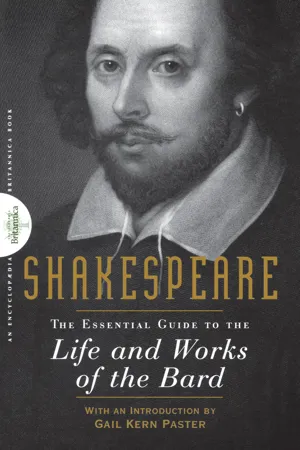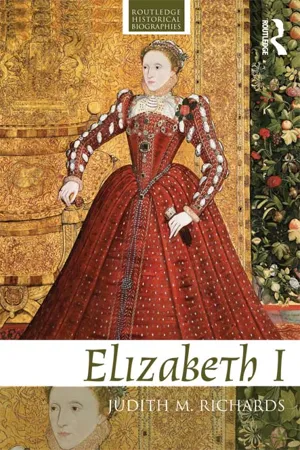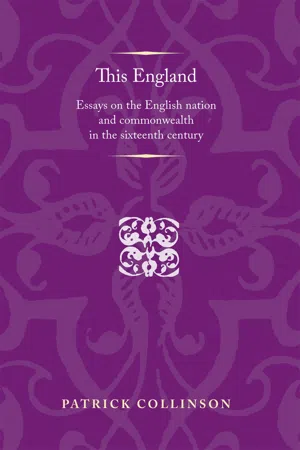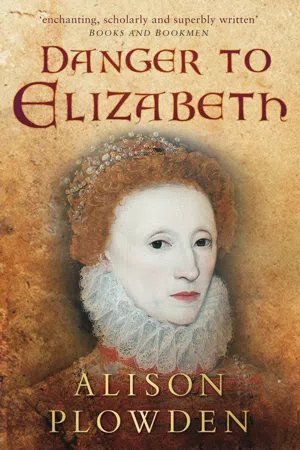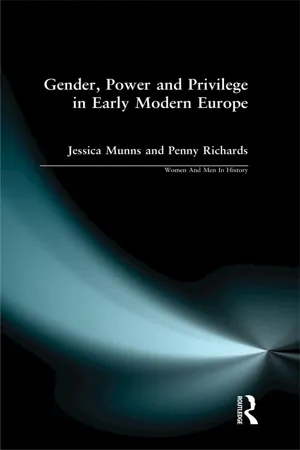History
Elizabeth I
Elizabeth I was the Queen of England and Ireland from 1558 to 1603. She was known for her long and successful reign, which saw the defeat of the Spanish Armada and the flourishing of English literature and exploration. Elizabeth's rule is often referred to as the Elizabethan era, a time of cultural and economic growth in England.
Written by Perlego with AI-assistance
Related key terms
7 Key excerpts on "Elizabeth I"
- eBook - ePub
Shakespeare
The Essential Guide to the Life and Works of the Bard
- (Author)
- 2006(Publication Date)
- Trade Paper Press(Publisher)
Elizabeth IElizabeth (1533–1603) was the queen of England during a period, often called the Elizabethan Age, when England asserted itself vigorously as a major European power in politics, commerce, and the arts. Her reign extended from 1558 until her death in 1603.Elizabeth I, the Armada portrait by Gower (d. 1596 ).Although her small kingdom was threatened by grave internal divisions, Elizabeth’s blend of shrewdness, courage, and majestic self-display inspired ardent expressions of loyalty and helped unify the nation against foreign enemies. The adulation bestowed upon her both in her lifetime and in the ensuing centuries was not altogether a spontaneous effusion; it was the result of a carefully crafted, brilliantly executed campaign in which the queen fashioned herself as the glittering symbol of the nation’s destiny. This political symbolism, common to monarchies, had more substance than usual, for the queen was by no means a mere figurehead. While she did not wield the absolute power of which Renaissance rulers dreamed, she tenaciously upheld her authority to make critical decisions and to set the central policies of both state and church. The latter half of the 16th century in England is justly called the Elizabethan Age: rarely has the collective life of a whole era been given so distinctively personal a stamp.Elizabeth’s early years were not auspicious. She was born at Greenwich Palace, the daughter of the Tudor king Henry VIII and his second wife, Anne Boleyn. Henry had defied the pope and broken England from the authority of the Roman Catholic church in order to dissolve his marriage with his first wife, Catherine of Aragon, who had borne him a daughter, Mary. Since the king ardently hoped that Anne Boleyn would give birth to the male heir regarded as the key to stable dynastic succession, the birth of a second daughter was a bitter disappointment that dangerously weakened the new queen’s position. Before Elizabeth reached her third birthday, her father had her mother beheaded on charges of adultery and treason. Moreover, at Henry’s instigation, an act of Parliament declared his marriage with Anne Boleyn invalid from the beginning, thus making their daughter Elizabeth Illegitimate, as Roman Catholics had all along claimed her to be. (Apparently the king was undeterred by the logical inconsistency of simultaneously invalidating the marriage and accusing his wife of adultery.) The emotional impact of these events on the little girl, who had been brought up from infancy in a separate household at Hatfield, is not known; presumably no one thought it worth recording. What was noted was her precocious seriousness; at six years old, it was admiringly observed, she had as much gravity as if she were 40. - eBook - ePub
- Judith M. Richards(Author)
- 2013(Publication Date)
- Routledge(Publisher)
10
What can be known ofElizabeth I?
Promoting or knowing Elizabeth?
As has been suggested several times in this study, many of the surviving sources for the reign of Elizabeth are imperfect, although she is by no means the only monarch for whom 16th and 17th century sources are often dubious. Indeed, royal biographies in the early modern era have more generally been described as belonging ‘inthe inter sections of chronicle, politic history, panegyric, martyrology, hagiography, confessional polemic and … ballads, poems, sermons, pageants, and plays’.1 That was indeed true in the case for Elizabeth Tudor, and identifying the actual Elizabeth within the propaganda that shaped her multiple representations remains a significant problem. Indeed, those polemics began even before she took the throne, at a time when her both personality and her abilities were hardly known beyond immediate court circles. As the only plausible Protestant counter to the triumphant Marian resurgence of Catholicism and as the legal heir to Mary, it was inevitable that she was widely praised and pronoetd by Protestant hopefuls.If the outpourings of praise and advice for Elizabeth were more plentiful than for other monarchs, one reason was that for so many of her subjects she remained a problematic monarch. Consequently her more supportive subjects competed to praise her ever more elaborately, not only to demonstrate their loyalty but also to persuade her to endorse their preferred judgements. Some of her doctrinal caution, a recurrent irritant to more zealous Protestants, was undoubtedly because, after Mary died in 1558, Elizabeth understood rather better than many of her advisers that she had inherited a predominantly Catholic realm. - eBook - ePub
Royal Portraits in Hollywood
Filming the Lives of Queens
- Elizabeth A. Ford, Deborah C. Mitchell(Authors)
- 2010(Publication Date)
- The University Press of Kentucky(Publisher)
Chapter SevenQueen Elizabeth I
I will have but one mistress and no master. —Elizabeth IImages of the Virgin Queen fast-forward across film history, unforgettable, iconic images: the stately bearing; the red wigs; the high forehead; the long, aristocratic nose; the alabaster makeup; the pearl-drop earrings; the stiff, ornate ruffs; the fingers dripping with jewels; and the gowns, with yards and yards of white satin, purple velvet, gold, and silver ornamented and sparkling with rubies, diamonds, and more pearls. Even a schoolchild would be hard-pressed to mistake her for any other monarch.As a case in point, this past fall, on one of our many visits to the National Portrait Gallery in London, we were strolling through the Tudor Rooms, contemplating the familiar faces of Elizabeth I and her entourage—Henry VII, Henry VIII, Mary Tudor, Robert Dudley, Francis Walsingham, William Cecil, Christopher Hatton, Sir Walter Raleigh, Sir Francis Drake, Robert Devereux, and others—when we happened on a primary school teacher and her class. The children, maybe seven or eight years old, all dressed neatly in their navy blue school uniforms, were sitting cross-legged on the floor in front of Elizabeth I’s coronation portrait. The teacher asked: “Now, who is this?” Twenty hands shot into the air. “Queen Elizabeth the First,” one child confidently answered. “Who was queen before Elizabeth?” Tiny voices in unison responded: “Her sister, Mary.” And so it went as the teacher took the children through a visual history lesson, moving from portrait to portrait of the Virgin Queen, her kindred, her courtiers, and her counselors. Their answers came swiftly, with a kind of assurance that only the very familiar breeds. How many times in their short lifetimes had they seen the imprint of that famous face? we wondered. Mesmerized, we followed the group until at last, two by two, in a quiet, orderly queue, they left the gallery, images of Gloriana sealed forever in their minds.Queen Elizabeth I. (Courtesy Victoria and Albert Museum, London/Art Resource, New York.) - eBook - ePub
This England
Essays on the English nation and Commonwealth in the sixteenth century
- Patrick Collinson(Author)
- 2013(Publication Date)
- Manchester University Press(Publisher)
Neale used to say ‘there are no pundits in history’, although Hurstfield suspected that he made an exception of himself. The 1590s were very different. John Guy has called them the second reign of Elizabeth, anticipating in many ways the early Stuart monarchy. 95 We need to go on discussing why that should have been so. The history of gender is now unavoidable, although it may be noticed that I have so far tried my level best to steer around it. There have been three or four books in the recent past on the implications of John Knox’s argument that female government (the ‘regiment’ of women) was unnatural government, and of the various responses to Knox. 96 We shall not necessarily agree on how important it was that Elizabeth was a woman, whether in all the circumstances there would have been a crisis, not so much of authority as of the directions to be taken by authority, even if she had been a gay man equally disinclined to marry, and to breed. Watch this space. How far does all this add up to an adverse verdict on Elizabeth I and her supposedly glorious rule? You may think that it must. Or, alternatively, you may conclude that for Elizabeth to have held her corner in these circumstances, to have become anything but a monarchical cipher, adds to our sense of her greatness; and that she was quite right, on all sorts of grounds, to have resisted the pressure to embrace more adventurous, expensive and risky policies. Biographers like Paul Johnson have praised her above all for her courageous conservatism, have made that their main theme. 97 But it is happenstance rather than policy which determines the course and outcome of a history like hers. Elizabeth gambled on the unlikely chance of living to the age that she did, outliving the problems which loomed so large in the 1570s and 1580s. The odds were long, and the stake was the very survival of England as a Protestant nation - eBook - ePub
- Alison Plowden(Author)
- 2011(Publication Date)
- The History Press(Publisher)
Even in her early twenties, the pale, sharp-featured, red-haired Elizabeth had never been able to compete with her Scottish cousin’s fabled beauty, but she possessed other attributes which were to prove of greater value in the long-drawn-out battle between them. As early as 1557, Michiel could comment respectfully on the excellence of her mind and on the wonderful intellect and understanding she had shown when facing danger and suspicion. She was proud, too, and haughty, he declared, in spite of the fact that her birth was regarded as illegitimate by most of Christian Europe and that her mother, the great-granddaughter of a London mercer, had once been commonly referred to as that goggle-eyed whore Nan Bullen. Nevertheless, Elizabeth It seemed did not regard herself as being of inferior degree to her half-sister the Queen, whose mother had been a Spanish princess of irreproachable lineage and virtue. ‘She prides herself on her father and glories in him’, wrote Michiel, adding that her resemblance to Henry VIII was remarked by everybody.Elizabeth’s greatest source of strength in the dismal days of her sister’s reign had always been her immense popularity, especially with the Londoners, and her accession was greeted with a spontaneous outburst of public rejoicing which has seldom been equalled. The uninhibited warmth of her welcome cannot be explained away by mere desire for a change, or relief that the transition had been accomplished peacefully. In the decade which had passed since King Henry’s death, the nation had suffered from the rule of greedy, factious juntas during the minority of Edward VI and the unpopular, inefficient government of a Queen accused of loving Spaniards and hating Englishmen. Mary Tudor had indeed leaned heavily on Spanish advisers and on her Spanish husband, who had ended by dragging the country into a ruinous war with France, culminating in the loss of Calais, last outpost of England’s once great Continental empire.Some people doubted whether another woman ruler would be much of an improvement, but there seems to have been a widespread, intuitive feeling that Henry VIII’s younger daughter was a genuine chip off the old block. Elizabeth was at least a full-blooded Englishwoman, unencumbered by foreign ties. Most important of all, she was young and healthy and with any luck would bear healthy sons. That apart, in the winter of 1558, she looked like being England’s last hope of peace and good government for a long time to come, and one senses an undercurrent of rather desperate optimism in the cheers, the pealing bells and salutes of guns which greeted the new Queen as she rode in procession through the City to the Tower on 28 November. - eBook - ePub
- Penny Richards, Jessica Munns(Authors)
- 2014(Publication Date)
- Routledge(Publisher)
21Finally, because it was centred on a true reading of Scripture, Reformation ideology in Europe collapsed the traditional division between temporal and spiritual authorities, symbolized before the Reformation by the relationship between pope and monarch, in ways that starkly problematized female rule. The problem was particularly acute in England, where the Henrician Reformation invested 'absolute' spiritual and temporal dominion (in relation to external powers) in a monarch newly denominated both an emperor and 'Supreme Head of the Church of England'. This new conception of imperial kingship raised a whole host of issues that reverberated through English political discourse from the time of Henry VIII's break with Rome through to the English Civil Wars. In a Bible-centred theocracy, whose role would it be to interpret Scripture? Was the task of establishing authoritative interpretation a matter for the king or some other form of spiritual authority? What should be the relationship between the two? If the king, as temporal authority, took it upon himself to fulfil this role, did this make him a priest? A bishop? A pope? What constraints, if any, might apply to this new creation, the imperial king? The legal writer Christopher St German (who feared that Henry's failings as a person included caesaropapal proclivities) tried to establish limits for the imperial king. He did so by figuring supreme headship as a collaborative endeavour enacted by king-in-parliament: 'Why should not the parliament then which representeth the whole catholic church of England expound scripture?22 This proved to be an influential model of the English imperial crown. In Elizabeth's reign, it privileged male political capacity, enacted pre-eminently in Parliament, the 'body of all England'. The role of authoritative scriptural exegete (or prophet) might, then, be available to a king, especially one joined in consultation with the 'whole catholic church of England'. It might extend to a minor king, imagined as a new Josiah attending to the wisdom of his godly councillors; hence the image of Edward VI as governed by godly preachers propagated in Elizabeth's reign.23 (See Figure 6.2 ) It would not be available under any circumstances to a queen whose gender disqualified her from exercising authority in spiritual or even what John Guy calls 'semi-spiritual' matters. 24 - eBook - ePub
A History of England, Volume 1
Prehistory to 1714
- Clayton Roberts, F David Roberts, Douglas Bisson(Authors)
- 2016(Publication Date)
- Routledge(Publisher)
Reverence for the Crown reached its zenith under Elizabeth, who exulted in the divinity attributed to her and exploited it shamelessly. A cult of the Queen arose in popular literature, portraying Elizabeth as a Goddess-Queen. But she was an accessible Goddess-Queen, for rarely did a summer pass that Elizabeth did not travel on a progress through her realm, displaying warmth and delight at the compliments showered on her. She used wisely the immense powers that the Crown brought her—powers to name ministers and judges, to summon and dismiss Parliament, to conduct diplomacy, to govern the Church, and to enforce order. Her deepest instinct was to use these powers to promote unity in the realm, not to pursue partisan or personal policies. Only once did she appear to yield to personal impulse. In the first years of her reign she fell deeply in love with Robert Dudley, whom she had first met at Edward VI's Court as a girl of 16. In 1562 the mysterious death of Dudley's wife, Amy Robsart, who either leaped into, fell into, or was pushed into a staircase well, presented an opportunity to consummate that love in marriage. But Elizabeth drew back. She saw the folly of marrying a man hated by most of her courtiers and suspected of murdering his wife. She turned from Dudley, saying, "I will have here but one mistress and no master."There were factions in Elizabeth's Court—a peace party led by Cecil, whom the Queen created Lord Burghley, and a war party led by Dudley, whom she made Earl of Leicester—but the Queen kept these factions under firm control, using the one to check the other. She never surrendered her judgment to a great Court favorite, as did James I, but rather supported or opposed a favorite as the balance of factions dictated. She also used the Court and her vast patronage to secure the loyalty of the great families of England. There were in Elizabethan England some 2500 peers, gentlemen, and the younger sons of peers and gentlemen who aspired to a place at Court or in the Household or in the government. To assuage their appetite for place and profit, the Crown had at its disposal about 1200 places, along with pensions, leases, monopolies, and lesser offices. Elizabeth distributed this patronage prudently, with the result that by the end of her reign peers and gentlemen were turning from conspiracy and rebellion in the countryside to faction and intrigue at Court as the final arbiter in politics.
Learn about this page
Index pages curate the most relevant extracts from our library of academic textbooks. They’ve been created using an in-house natural language model (NLM), each adding context and meaning to key research topics.
